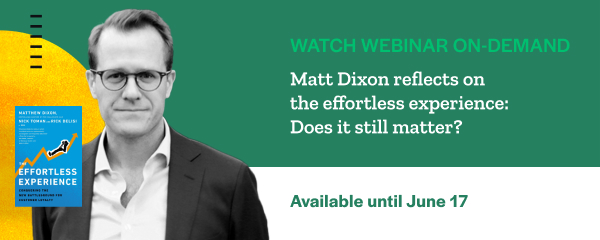Matt Dixon reflects on the effortless experience: Does it still matter?

Almost a decade has passed since Matt Dixon’s “The Effortless Experience” transformed the way organizations think about customer experience. The book revealed that delighting your customers won’t bring them back. Rather, customer loyalty depends on how easy you make it for your customers to do business with you.
Now, a decade and global pandemic later, we’re left with questions; is an effortless experience still all you need to keep customers happy? What does low-effort even look like today? Or is there a new key to customer loyalty?
Watch this 1-hour recorded webinar, featuring Matt Dixon, author of “The Effortless Experience,” and Shelbi Scott, director of CX at GetFeedback, as we explore the answers to many of these burning questions.

Matthew Dixon, Ph.D.
Author of The Effortless Experience: Conquering the New Battleground for Customer Loyalty
Matt Dixon is one of the world’s foremost experts in sales and customer experience. He is the author of The Effortless Experience: Conquering the New Battleground for Customer Loyalty (Portfolio/Penguin 2013), which introduced the concept of customer effort reduction and the Customer Effort Score to companies around the world. Known for his ground-breaking research, he is a frequent contributor to Harvard Business Review and is the author of some of the most important business books of the past decade. Matt is a seasoned practitioner having held executive leadership roles in strategy, new product development, product management, research and innovation for companies like Tethr, Korn Ferry Hay Group and CEB (now Gartner).

Shelbi Scott
Director of CX, GetFeedback
Shelbi has over 20 years of customer journey and digital engagement experience. Prior to Momentive, Shelbi built and led a Strategic Customer Engagement team working with Fortune 100 clients to improve their NPS, CES, GCR and CSAT scores, while reducing operational costs, and increasing revenue.